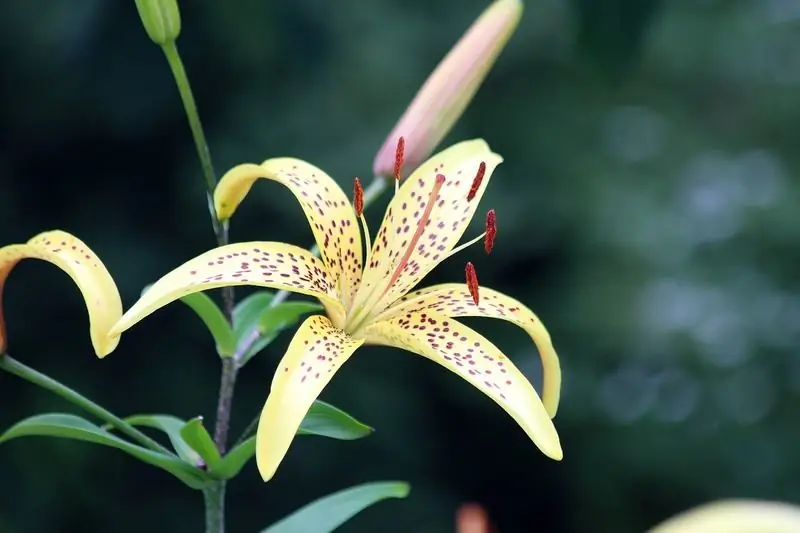
Table of contents:
- Author Bailey Albertson [email protected].
- Public 2023-12-17 12:53.
- Last modified 2025-06-01 07:32.
Preparing lilies for winter: what to do to make the flowers survive the cold

Lilies deservedly have a reputation for being rather capricious and demanding flowers. Moreover, they need competent care throughout the active growing season, including after flowering. The frost resistance of many varieties is such that they will not survive the harsh Russian winters without preliminary preparation.
Content
- 1 How lilies winter
- 2 When they begin to prepare flowers for winter
-
3 Pruning lilies after flowering
3.1 Video: how to properly crop lilies in the fall
-
4 Fertilization
4.1 Video: caring for lilies after flowering
- 5 Disease prevention, pest control
- 6 Proper watering
-
7 Shelter flowers for the winter
7.1 Video: preparing lilies for winter on personal experience
- 8 Do I need to dig up the bulbs
How lilies winter
Different types of lilies are very different in frost resistance. Climatic conditions in Russia also vary greatly. Therefore, the same variety in different regions can overwinter without shelter, and require digging out the bulbs. The most cold-resistant are Asian, royal, Daurian, curly (Martagon) lilies, and the most thermophilic are tubular, oriental and American hybrids. They can only be left in the soil in southern regions with a subtropical climate.

The frost resistance of lilies varies depending on the type and variety; studying the description, be sure to focus on this
For the central part of Russia, generally rather mild, but snowy winters are characteristic. In such conditions, many varieties are able to overwinter even without shelter. But if the winter is forecast with little snow, it will definitely be needed.
The climate of the Urals, Siberia and the Far East is much more severe. Here lilies must be dug up in the fall, or they will simply freeze out.
When they start to prepare flowers for winter
Preparing lilies for winter includes the same actions, but carried out at different times. This is due to the climatic characteristics of the regions. The fact that it's time to start is signaled by the appearance of the plant - the lily dries up, the leaves and stems dry out.
In central Russia, this happens in late September or early October. In the Urals and Siberia - 1.5-2 weeks earlier. In the southern regions, on the contrary, it is 2.5-3 weeks later.

Take your time to prepare the lily for winter, hasty actions will negatively affect the normal development of the plant
Pruning lilies after flowering
In summer, pruning of lilies is limited to the removal of faded buds. If this is not done, the plant will spend energy on the formation of seeds, which are useless for the gardener - in hybrids with the generative method of reproduction, varietal characteristics are still not preserved.
When the stems dry up, this is a signal that all the nutrients have passed into the bulb. Now they can be cut, leaving "hemp" 10-15 cm high.

Pruning lilies is an extremely simple procedure; you just need to shorten the stems
In no case should lilies be cut off immediately after flowering. This disrupts the ripening of the bulbs and the life of the plant - it will not be able to accumulate enough nutrients for wintering and grow roots.

Pruning lilies too early is one of the most serious mistakes a gardener makes when preparing them for winter.
Video: how to properly trim lilies in the fall
Fertilization
10-12 days after the end of flowering, lilies are fed. Plants need phosphorus and potassium to prepare for winter:
-
Simple superphosphate and potassium sulfate (30-40 g each). Depending on whether the autumn is dry or rainy, fertilizer is applied dry (then this is the norm for 1 m²) or the flowerbed is watered with a solution (the same amount of fertilizer per 10 liters of water, this volume is consumed for about the same area).

Superphosphate and potassium sulfate Superphosphate and potassium sulfate are mineral fertilizers that provide lilies with phosphorus and potassium, which they need for normal wintering
-
Special shop "autumn" fertilizer without nitrogen content (ABA, Autumn). The dosage is determined in the instructions.

"Autumn" fertilizer "Autumn" fertilizer can be universal or designed specifically for perennial flowers
-
Sifted wood ash, bone meal. Application rate - a glass under the plant. You can also prepare an infusion from ash by pouring 2-3 kg of raw materials with 10 liters of boiling water. He is ready in 5-6 hours. 1.5-2 liters are spent on a lily. Using natural fertilizers, keep in mind that they normalize the acid-base balance of acidic soil, and neutralize it. Therefore, they are not suitable for American, Asian, Oriental lilies, LA hybrids that prefer acidic soil.

Wood ash Wood ash is a natural source of potassium and phosphorus, it is also a soil deoxidizer
To maintain the fertility of the soil, once every 2-3 years in the spring or autumn, apply humus or ready-made compost under the lilies - 5-7 m / ².
Video: caring for lilies after flowering
Disease prevention, pest control
Preventive treatments are carried out annually in spring and autumn. Pruning of plants partially solves the problem - spores of fungi, eggs and larvae that remain to winter on the stems are removed. It is also necessary to spray the "hemp" remaining from the lilies and the soil in the flower bed with 2% copper sulfate, Bordeaux liquid or a solution of any fungicide (dosage and consumption rate are determined in the instructions).

For the treatment of lilies, you can use any fungicides - from long and well-known to gardeners of copper sulfate and Bordeaux liquid to modern preparations of biological origin
Of the pests of lilies, thrips, aphids, and a lily fly are most often attacked. Any general action insecticides - Mospilan, Spark Double Effect, Aktara will help prevent their appearance. The treatment is carried out 7-10 days after spraying with fungicides.

Aphids are distinguished by their rare "omnivorous", they attack almost any garden crops with whole colonies
Proper watering
Watering lilies is stopped by mid-August. From this time on, plants get by with natural precipitation. Waterlogged soil provokes the development of rot and other fungal diseases.
Shelter flowers for the winter
If the lily bulbs are not planned to be dug up for the winter, the bases of the stems are covered with peat, humus, compost, forming a "mound" with a height of at least 15-20 cm. You can also cover the plants with suitable sized cardboard boxes, filling them with scraps of newsprint, straw, wood shavings … Tubular, oriental, American hybrids, in addition to mulching, are recommended to be additionally covered by throwing spruce branches, fallen leaves, sawdust and tightening the flower bed with 2-3 layers of covering material.

When constructing a shelter for a lily for the winter, focus on the frost resistance of the variety and a long-term weather forecast
As soon as enough snow falls, it is shoveled into the flower bed. In winter, this snowdrift gradually settles, 2-3 times per season it will have to be renewed, while breaking the crust of the infusion on the surface.
Video: preparing lilies for winter on personal experience
Do I need to dig up the bulbs
The heat-loving lilies left in the soil will not survive the harsh Russian winter. It is also worth playing it safe if you are growing new varieties for which you do not have reliable information about frost resistance, or rare, unique varieties.
Some varieties of Asian lilies need to be dug out for more than just protection from the cold. They have daughter bulbs, if they are not separated in the fall, during the winter they grow so tightly to the mother bulbs that it will not be possible to separate them later without "injuries". In the spring, "children" take away water and nutrients from the main plant, which means a slowdown in its growth and development, scarcity of flowering.
The bulbs are dug out after pruning the lilies:
-
Gently pry the soil with a pitchfork, 25-30 cm away from the base of the stem. Remove the bulbs from the ground.

Digging up lily bulbs It is better to use a pitchfork to dig up lilies - this way there is less risk of damaging the bulbs
-
Shake off the earth from them, separate the "kids", rinse in cool water.

Cleansing lily bulbs from soil First of all, shake off the soil from the lily bulbs extracted from the soil.
-
Examine the bulbs, remove dry scales. Cut off rotten and dry areas to healthy tissue.

Peeled lily onion Washed lily bulbs are cleaned, badly damaged ones are thrown away
-
Soak the bulbs in a bright pink solution of potassium permanganate for 3-4 hours. It can also be disinfected in a solution of any fungicide, the processing time is reduced to 20-30 minutes.

Potassium permanganate solution Potassium permanganate is an effective and affordable disinfectant
- Sprinkle all the sections made with crushed chalk, activated carbon, sifted wood ash.
- Spread the bulbs on paper, cloth, wait until they are completely dry.
Only completely dry lily bulbs are removed for storage. In winter, they are kept in a cool (temperature no more than 10 ° C, preferably 6-8 ° C) dark room with good ventilation, maintaining the air humidity at 70-75%. The bulbs are put in cardboard boxes, wooden boxes, sprinkled with sawdust, sand, shavings, straw so that they do not come into contact with each other.
The frost resistance of different types of lilies varies greatly, the climatic conditions in the regions of Russia are also different. Consider both of these factors when deciding whether to dig up the bulbs in the fall, whether they are able to overwinter under cover or without it. In any case, after flowering, one should not forget about the plants, at this time the lilies also need care.
Recommended:
Garden Lilies - Planting And Care, Photo And Video (oriental, White, Tubular)

Features of the species and varieties of garden lilies. Tips for planting lily bulbs. advice on growing and care
Raspberry Care In Autumn, Preparation For Winter

How to care for raspberries in the fall. Pruning, feeding and mulching. Ducking and covering raspberry bushes for the winter. Features of caring for remontant raspberries
How To Fertilize Peonies In Autumn For Health And Lush Flowering In Spring: Folk And Store Remedies

How to fertilize peonies in the fall. What can be used to feed peonies
Manicure Autumn - Fashionable Autumn Trends In Nail Design And Photos Of Beautiful New Products

What fashion trends are relevant in manicure in the fall of 2019 What techniques should be used. Various styles, colors and other nuances
Fashionable Women's Jackets Fall-winter 2019-2020: Current Trends, Photos Of Autumn And Winter Novelties

Which women's jackets will be in fashion in the fall and winter of 2019. What models and styles, colors and prints are relevant this year. The best demi-season, warm jackets
